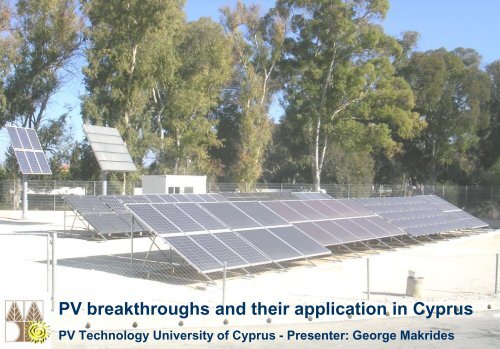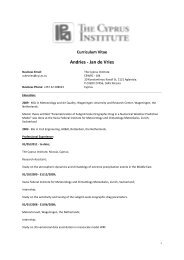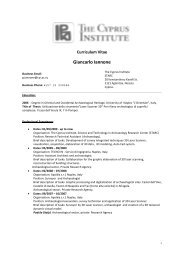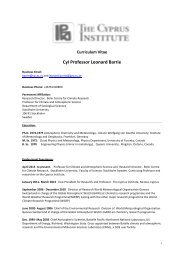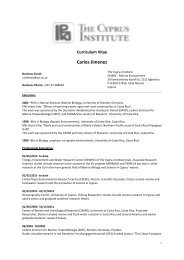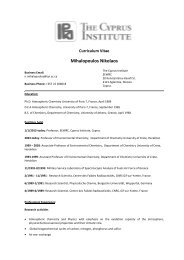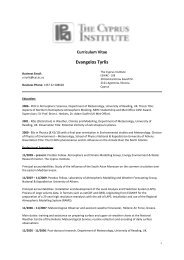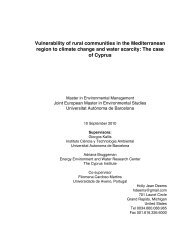Click to edit Master title style - The Cyprus Institute
Click to edit Master title style - The Cyprus Institute
Click to edit Master title style - The Cyprus Institute
You also want an ePaper? Increase the reach of your titles
YUMPU automatically turns print PDFs into web optimized ePapers that Google loves.
University of <strong>Cyprus</strong><br />
Pho<strong>to</strong>voltaic Technology<br />
<strong>Click</strong> <strong>to</strong> <strong>edit</strong> <strong>Master</strong><br />
<strong>title</strong> <strong>style</strong><br />
1<br />
PV breakthroughs and their application in <strong>Cyprus</strong><br />
PV Technology University of <strong>Cyprus</strong> - Presenter: George Makrides
University of <strong>Cyprus</strong><br />
Pho<strong>to</strong>voltaic Technology<br />
Acknowledgements<br />
• <strong>Institute</strong> of Physical Electronics<br />
University of Stuttgart<br />
• <strong>Cyprus</strong> Research Promotion Foundation<br />
• European Commission<br />
• Electricity Authority of <strong>Cyprus</strong><br />
2
University of <strong>Cyprus</strong><br />
Pho<strong>to</strong>voltaic Technology<br />
Outline<br />
• Introduction - Motivation - Potential<br />
• PV breakthroughs<br />
• Applications in <strong>Cyprus</strong><br />
• UCY PV performance assessment<br />
• Results<br />
• Conclusions<br />
3
University of <strong>Cyprus</strong><br />
Pho<strong>to</strong>voltaic Technology<br />
Introduction<br />
• Energy problem – Environmental<br />
consequence of fossil fuels usage<br />
(Global Warming).<br />
• “As a result, the earth has a fever and the<br />
fever is rising. It is time <strong>to</strong> make peace<br />
with this planet.” Al Gore 2007 Nobel.<br />
4
University of <strong>Cyprus</strong><br />
Pho<strong>to</strong>voltaic Technology<br />
Motivation<br />
• Urgent requirement <strong>to</strong>wards more<br />
sustainable sources of energy.<br />
• Solar irradiation in <strong>Cyprus</strong> is one of the<br />
highest in Europe.<br />
• Proof of the enormous prospect and<br />
potential of this technology in <strong>Cyprus</strong>.<br />
Source: Meteonorm 6.0<br />
5
University of <strong>Cyprus</strong><br />
Pho<strong>to</strong>voltaic Technology<br />
Best research cell efficiencies<br />
6
University of <strong>Cyprus</strong><br />
Pho<strong>to</strong>voltaic Technology<br />
Trends in cell efficiencies<br />
7
University of <strong>Cyprus</strong><br />
Pho<strong>to</strong>voltaic Technology<br />
Key characteristics of commercially available modules<br />
Technology Material thickness (μm) Module area (m 2 ) Efficiency (%) Surface area for 1 kW p system (m 2 )<br />
Mono-c-Si 200 1.4 - 1.7 (typical) 14 - 20 ~7<br />
Multi-c-Si 160 1.4 - 1.7 (typical)<br />
2.5 (up <strong>to</strong>)<br />
11 - 15 ~8<br />
CIGS ~2 ~0.6 - 1 7 - 12 ~10<br />
CdTe ~1 - 3 ~0.6 - 1 10 - 11 ~10<br />
a-Si/μc-Si 2 ~1.4 7 - 9 ~12<br />
a-Si 1 ~1.5 4 - 8 ~15<br />
8
University of <strong>Cyprus</strong><br />
Pho<strong>to</strong>voltaic Technology<br />
Grid-connected PV systems<br />
9<br />
Module<br />
System<br />
Grid
University of <strong>Cyprus</strong><br />
Pho<strong>to</strong>voltaic Technology<br />
Pho<strong>to</strong>voltaic Park UCY<br />
• In order <strong>to</strong> evaluate the PV performance outdoors in <strong>Cyprus</strong> we have installed 5<br />
years ago in collaboration with the <strong>Institute</strong> of Physical Electronics, University of<br />
Stuttgart, the PV Park<br />
10
University of <strong>Cyprus</strong><br />
Pho<strong>to</strong>voltaic Technology<br />
PV System Technologies<br />
• Monocrystalline Silicon (Atersa)<br />
• Multicrystalline Silicon (SolarWorld, Solon)<br />
• Amorphous Silicon (Schott Solar, MHI)<br />
• EFG and Main (Schott Solar)<br />
• Saturn Cell (BP)<br />
• Back Contact Cell (Sunpower)<br />
• HIT (Sanyo)<br />
• Cadmium Telluride (First Solar)<br />
• Copper Indium Diselenide, CIS (Wurth)<br />
• Tracked System<br />
• Concentra<strong>to</strong>r System (Concentrix Solar)<br />
Tracker and<br />
Concentrating Technologies<br />
Amorphous Silicon<br />
and other thin film Technologies<br />
Monocrystalline Technologies<br />
High Efficiency Multicrystalline Technologies Technologies<br />
11
University of <strong>Cyprus</strong><br />
Pho<strong>to</strong>voltaic Technology<br />
PV Measurement system<br />
12
University of <strong>Cyprus</strong><br />
Pho<strong>to</strong>voltaic Technology<br />
Other infrastructure – Outdoor PV characterization<br />
13
University of <strong>Cyprus</strong><br />
Pho<strong>to</strong>voltaic Technology<br />
Other infrastructure – Indoor PV testing<br />
14
University of <strong>Cyprus</strong><br />
Pho<strong>to</strong>voltaic Technology<br />
Outdoor PV Performance vs STC<br />
• <strong>The</strong> applicability and performance of PV<br />
technologies is proven only from outdoor<br />
assessments.<br />
• This is because manufacturer information only<br />
includes specifications at rated conditions the<br />
Standard Test Conditions (STC)<br />
• 1000 W/m 2 solar irradiance<br />
• 25 °C cell temperature<br />
• AM 1.5<br />
• STC conditions rarely occur in the field.<br />
Environmental<br />
Temperature<br />
Angle of Incidence<br />
Low Light<br />
Spectrum<br />
Operational<br />
Degradation<br />
Inverter and wiring.<br />
15
University of <strong>Cyprus</strong><br />
Pho<strong>to</strong>voltaic Technology<br />
Measured vs modeled energy yield results<br />
Systems<br />
Measured<br />
Single-point<br />
efficiency<br />
Single-point<br />
efficiency<br />
and temperature<br />
PVUSA<br />
One-diode<br />
E DC<br />
(kWh/kW p )<br />
E DC<br />
(kWh/kW p )<br />
APE<br />
(%)<br />
E DC<br />
(kWh/kW p )<br />
APE<br />
(%)<br />
E DC<br />
(kWh/kW p )<br />
APE<br />
(%)<br />
E DC<br />
(kWh/kW p )<br />
APE<br />
(%)<br />
Atersa (A-170M 24V) 1810 2054 -13.47 1918 -5.96 1919 -6.02 1871 -3.35<br />
BP Solar (BP7185S) 1593 2054 -28.93 1845 -15.84 1806 -13.38 1838 -15.39<br />
Sanyo (HIP-205NHE1) 1814 2054 -13.25 1938 -6.86 1922 -5.98 1864 -2.77<br />
Suntechnics (STM 200 FW) 1890 2054 -8.67 1912 -1.18 2012 -6.47 1853 1.98<br />
Schott Solar (ASE-165-GT/MC) 1810 2054 -13.45 1881 -3.92 1950 -7.72 1788 1.24<br />
Schott Solar (ASE-260-DG-FT) 1783 2054 -15.23 1866 -4.70 1892 -6.13 1785 -0.16<br />
SolarWorld (SW165) 1772 2054 -15.89 1858 -4.82 1838 -3.73 1773 -0.02<br />
Solon (P220/6+) 1761 2054 -16.64 1878 -6.64 1889 -7.27 1859 -5.59<br />
MHI (MA100T2) 1734 2054 -18.42 1982 -14.28 1844 -6.32 2283 -31.64<br />
Schott Solar (ASIOPAK-30-SG) 1650 2054 -24.46 1974 -19.63 1782 -8.01 2313 -40.16<br />
Würth (WS 11007/75) 1863 2054 -10.24 1877 -0.73 2031 -9.00 1756 5.78<br />
First Solar (FS60) 1752 2054 -17.26 1944 -10.96 1930 -10.17 2523 -44.05<br />
Average 1769 2054 -16.33 1906 -7.96 1901 -7.52 1959 -11.17<br />
G. Makrides, B. Zinsser, M. Schubert and G. E. Georghiou, Energy yield prediction errors and uncertainties of different pho<strong>to</strong>voltaic<br />
models. Progress in Pho<strong>to</strong>voltaics: Research and Applications, 2011, DOI: 10.1002/pip.1218<br />
16
University of <strong>Cyprus</strong><br />
Pho<strong>to</strong>voltaic Technology<br />
<strong>The</strong>rmal effects<br />
• Initially, we have evaluated the temperature<br />
coefficients which denote the fac<strong>to</strong>rs by which<br />
power is lost by the increase of module<br />
temperature.<br />
• Outdoor technique. Tests were performed during<br />
midday and calm conditions.<br />
• Indoor technique. Temperature coefficients<br />
calculated through data analysis.<br />
Cover <strong>to</strong> shade module<br />
Uncovered module<br />
Temperature sensor<br />
at the back of module<br />
IV curve acquisition<br />
17
University of <strong>Cyprus</strong><br />
Pho<strong>to</strong>voltaic Technology<br />
<strong>The</strong>rmal effects<br />
7%<br />
8%<br />
9%<br />
9%<br />
7%<br />
5%<br />
8%<br />
4%<br />
10%<br />
3%<br />
18<br />
8%<br />
9%
University of <strong>Cyprus</strong><br />
Pho<strong>to</strong>voltaic Technology<br />
Degradation / Progressive performance loss<br />
100<br />
DC performance ratio (%)<br />
90<br />
80<br />
70<br />
y = -0.1019x + 90.63<br />
60<br />
DC PR time series<br />
10 (b) Sanyo HIT mono-c-Si<br />
Linear fit<br />
0<br />
Jun-06 Dec-06 Jun-07 Dec-07 Jun-08 Dec-08 Jun-09 Dec-09 Jun-10<br />
• Yearly performance loss rate of c-Si technologies was approximately -1 %/year and lower.<br />
• Yearly performance loss rate of thin-film was -2 %/year apart from the Würth CIGS and<br />
the tandem-junction amorphous silicon (a-Si) system.<br />
19
AC-Energy Yield [kWhAC /kWp rated ]<br />
University of <strong>Cyprus</strong><br />
Pho<strong>to</strong>voltaic Technology<br />
Performance vs Climatic Conditions (<strong>Cyprus</strong> and Germany)<br />
• <strong>The</strong> high PV potential in <strong>Cyprus</strong> became more obvious by comparing the energy yield<br />
produced by the same systems installed both in <strong>Cyprus</strong> and Germany.<br />
• Average annual solar irradiation about 2000 kWh/m 2 in Nicosia while in Stuttgart about<br />
1350 kWh/m 2<br />
2200<br />
2000<br />
1800<br />
Stuttgart<br />
Nicosia<br />
average<br />
1600<br />
1580<br />
1)<br />
1400<br />
1200<br />
1194<br />
10000 02468 0<br />
monocrystalline<br />
BP mono-c-Si<br />
Atersa mono-c-Si<br />
Sanyo HIT-Si<br />
SunPower mono-c-Si<br />
Schott MAIN-Si<br />
multicrystalline<br />
Schott EFG-Si<br />
Solon multi-c-Si<br />
SolarWorld multi-c-Si<br />
Mitsubishi a-Si(1)<br />
Schott a-Si(2)<br />
thin film<br />
First Solar CdTe<br />
Würth CIGS<br />
20
University of <strong>Cyprus</strong><br />
Pho<strong>to</strong>voltaic Technology<br />
Potential application of PV in <strong>Cyprus</strong> – CPV systems<br />
Lens<br />
• Promising technology for countries with<br />
high direct normal irradiation<br />
• Use of lenses <strong>to</strong> reduce cell area<br />
• Higher efficiencies<br />
• Reduced costs<br />
Cell<br />
21
University of <strong>Cyprus</strong><br />
Pho<strong>to</strong>voltaic Technology<br />
Current activities in the field of CPV<br />
• Development of solar tracker system<br />
• Outdoor module moni<strong>to</strong>ring and evaluation<br />
• New Cell characterisation<br />
• Long-term CPV moni<strong>to</strong>ring<br />
• CPV System Characterisation<br />
• Contributions <strong>to</strong> IEC TC 82 WG 7<br />
• Outdoor characterisation of CPV modules<br />
• CPV System characterisation<br />
• Contributions <strong>to</strong> IEC TC 82 WG 7<br />
22
University of <strong>Cyprus</strong><br />
Pho<strong>to</strong>voltaic Technology<br />
CPV energy yield evaluations<br />
23
University of <strong>Cyprus</strong><br />
Pho<strong>to</strong>voltaic Technology<br />
Conclusions<br />
• PV BRIGHT FUTURE<br />
• Real performance deviates from STC performance and for this reason outdoor PV<br />
performance investigations are important.<br />
• Physical models require the inclusion of other effects such as spectral, temperature,<br />
low light, degradation etc <strong>to</strong> adequately predict system performance.<br />
• High temperature is the main loss fac<strong>to</strong>r in warm climates such as <strong>Cyprus</strong>.<br />
• PV systems installed in <strong>Cyprus</strong> provide as much as 30 % more energy compared <strong>to</strong><br />
Germany.<br />
• CPV is an ideal candidate technology for regions with high DNI.<br />
24
University of <strong>Cyprus</strong><br />
Pho<strong>to</strong>voltaic Technology<br />
Website Information<br />
• More information on our website<br />
– www.pvtechnology.ucy.ac.cy<br />
25
University of <strong>Cyprus</strong><br />
Pho<strong>to</strong>voltaic Technology<br />
Thank you for your attention<br />
Contacts Us<br />
Dr. George E. Georghiou<br />
Contacts Us<br />
Mr. George Makrides<br />
Associate Professor UCY<br />
75 Kallipoleos, Nicosia 1678<br />
<strong>Cyprus</strong><br />
Tel: 22-892272<br />
Fax: 22-892260<br />
Email: geg@ucy.ac.cy<br />
Web Links: www.ece.ucy.ac.cy<br />
Website: www.pvtechnology.ucy.ac.cy<br />
Research Associate UCY<br />
75 Kallipoleos, Nicosia 1678<br />
<strong>Cyprus</strong><br />
Tel: 22-892272<br />
Fax: 22-892260<br />
Email: eep5mg1@ucy.ac.cy<br />
Web Links: www.ece.ucy.ac.cy<br />
Website: www.pvtechnology.ucy.ac.cy<br />
26


